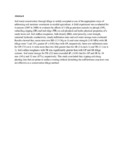The effects of tillage systems on soil physical properties and water conservation in a sandy loam soil in Eastern Kenya

Date
2013Author
Miriti, J M
Kironchi, G
Esilaba, A O
Gachene, C K K
Heng, L K
Mwangi, D M
Language
enMetadata
Show full item recordAbstract
Soil water conservation through tillage is widely accepted as one of the appropriate ways of addressing
soil moisture constraints in rainfed agriculture. A field experiment was conducted for 6 seasons (2007
to 2009) to evaluate the effects of 3 tillage practices namely ox-plough (OP), subsoiling-ripping (SR) and
tied-ridge (TR) on soil physical and hydro-physical properties of a sandy loam soil. Soil surface
roughness, bulk density (BD), total porosity, crust strength, saturated hydraulic conductivity, steady
infiltration rates and soil water storage were evaluated. Results showed that, mean inter-row BD (1.51
Mg m-3) and crust strength (3.05 MPa) with SR tillage were 7 and 15% greater (P ≤ 0.05) than with OP,
respectively. Inter-row infiltration rates for OP (7.9 cm h-1) were more than two fold greater than for SR
(3.6 cm h-1) and TR (3.3 cm h-1). Soil surface roughness with TR was significantly greater than with OP
and SR tillage systems. Soil water storage for TR (222 mm) exceeded (P ≤ 0.05) that for OP and SR by 30
mm (16%) and 32 mm (17%), respectively. This study concluded that, ripping soil along planting line
that are prone to surface crusting without disturbing the soil between crop rows was not effective as a
conservation tillage method.
Citation
Miriti, J. M., Kironchi, G., Esilaba, A. O., Gachene, C. K. K., Heng, L. K., & Mwangi, D. M. (2013). The effects of tillage systems on soil physical properties and water conservation in a sandy loam soil in Eastern Kenya. Journal of Soil Science and Environmental Management, 4(7), 146-154.Publisher
University of Nairobi
Collections
- Faculty of Agriculture [225]
